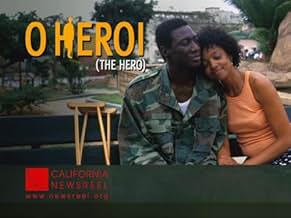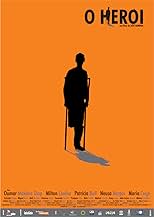A 20-year veteran of the Angolan civil war returns to the capital city of Luanda where he faces the challenges of assimilation and survival.A 20-year veteran of the Angolan civil war returns to the capital city of Luanda where he faces the challenges of assimilation and survival.A 20-year veteran of the Angolan civil war returns to the capital city of Luanda where he faces the challenges of assimilation and survival.
- Awards
- 6 wins & 1 nomination
Photos
Makena Diop
- Vitorio
- (as Oumar Makena Diop)
Neusa Borges
- Flora
- (as Neuza Borges)
- Director
- Writers
- All cast & crew
- Production, box office & more at IMDbPro
Storyline
Did you know
- ConnectionsReferences The Mysterious Lady (1928)
Featured review
Involving story of life in the Angolan capital Luanda. Vitório is a veteran of the liberation war and subsequent civil war, has lost a leg to a landmine and has to try and get by on the streets, while looking for work and love - trying to find a way to fit back into society.
Meanwhile Manu a schoolboy has his own struggles going on; brought up by his grandmother he wants to search for his father (missing in the war), gets involved in petty crime and tries to avoid the local hoodlums. His teacher Joana does her best to keep him in school.
Eventually all the characters' paths cross in a variety of ways.
The film is basically a portrait of Luanda as it tries to recover from years of war and disruption. People everywhere are trying to rebuild their lives, find missing friends or relatives and make ends meet. Obviously life is very hard for most, but considerably easier for others - mainly those in the government and their relatives.
This is the sort of film Ken Loach might make if he lived in Africa. Through the individual stories of the characters numerous political and social issues are teased out, for the most part with considerable subtlety. Class relations, the role of politics, the situation of women (and such women - phew...), the landmine issue (70,000 Angolans have lost limbs and much of the country is still mined) and the desperate struggle to survive are all woven in.
There are some stunning aerial shots of Luanda at the start and end of the film, but in general the camera serves the actors and the story rather than the other way round. The standard of acting is generally high. There's nothing groundbreaking in cinematic terms here, but the film is a valuable window into the daily life of a society and a continent normally represented in the Western media only by images of war and famine.
Meanwhile Manu a schoolboy has his own struggles going on; brought up by his grandmother he wants to search for his father (missing in the war), gets involved in petty crime and tries to avoid the local hoodlums. His teacher Joana does her best to keep him in school.
Eventually all the characters' paths cross in a variety of ways.
The film is basically a portrait of Luanda as it tries to recover from years of war and disruption. People everywhere are trying to rebuild their lives, find missing friends or relatives and make ends meet. Obviously life is very hard for most, but considerably easier for others - mainly those in the government and their relatives.
This is the sort of film Ken Loach might make if he lived in Africa. Through the individual stories of the characters numerous political and social issues are teased out, for the most part with considerable subtlety. Class relations, the role of politics, the situation of women (and such women - phew...), the landmine issue (70,000 Angolans have lost limbs and much of the country is still mined) and the desperate struggle to survive are all woven in.
There are some stunning aerial shots of Luanda at the start and end of the film, but in general the camera serves the actors and the story rather than the other way round. The standard of acting is generally high. There's nothing groundbreaking in cinematic terms here, but the film is a valuable window into the daily life of a society and a continent normally represented in the Western media only by images of war and famine.
- Krustallos
- Oct 28, 2004
- Permalink
Details
- Runtime1 hour 37 minutes
- Color
- Sound mix
- Aspect ratio
- 1.66 : 1
Contribute to this page
Suggest an edit or add missing content





